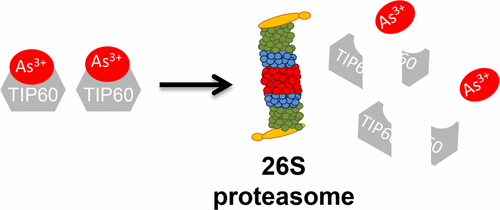当前位置:
X-MOL 学术
›
Chem. Res. Toxicol.
›
论文详情
Our official English website, www.x-mol.net, welcomes your
feedback! (Note: you will need to create a separate account there.)
Arsenite Binds to the Zinc Finger Motif of TIP60 Histone Acetyltransferase and Induces Its Degradation via the 26S Proteasome
Chemical Research in Toxicology ( IF 3.7 ) Pub Date : 2017-09-07 00:00:00 , DOI: 10.1021/acs.chemrestox.7b00146 Lok Ming Tam 1 , Ji Jiang 1 , Pengcheng Wang 1 , Lin Li 1 , Weili Miao 1 , Xuejiao Dong 1 , Yinsheng Wang 1
Chemical Research in Toxicology ( IF 3.7 ) Pub Date : 2017-09-07 00:00:00 , DOI: 10.1021/acs.chemrestox.7b00146 Lok Ming Tam 1 , Ji Jiang 1 , Pengcheng Wang 1 , Lin Li 1 , Weili Miao 1 , Xuejiao Dong 1 , Yinsheng Wang 1
Affiliation

|
Arsenic is a ubiquitous environmental contaminant with widespread public health concern. Epidemiological studies have revealed that chronic human exposure to arsenic in drinking water is associated with the prevalence of skin, lung, and bladder cancers. Aberrant histone modifications (e.g., methylation, acetylation, and ubiquitination) were previously found to be accompanied by arsenic exposure; thus, perturbation of epigenetic pathways is thought to contribute to arsenic carcinogenesis. Arsenite is known to interact with zinc finger motifs of proteins, and zinc finger motif is present in and indispensable for the enzymatic activities of crucial histone-modifying enzymes especially the MYST family of histone acetyltransferases (e.g., TIP60). Hence, we reasoned that trivalent arsenic may target the zinc finger motif of these enzymes, disturb their enzymatic activities, and alter histone acetylation. Herein, we found that As3+ could bind directly to the zinc-finger motif of TIP60 in vitro and in cells. In addition, exposure to As3+ could lead to a dose-dependent decrease in TIP60 protein level via the ubiquitin-proteasome pathway. Thus, the results from the present study revealed, for the first time, that arsenite may target cysteine residues in the zinc-finger motif of the TIP60 histone acetyltransferase, thereby altering the H4K16Ac histone epigenetic mark. Our results also shed some new light on the mechanisms underlying the arsenic-induced epigenotoxicity and carcinogenesis in humans.
中文翻译:

砷结合到TIP60组蛋白乙酰转移酶的锌指基序上,并通过26S蛋白酶体诱导其降解。
砷是一种普遍存在的环境污染物,受到广泛的公共健康关注。流行病学研究表明,人类长期饮用水中砷的暴露与皮肤癌,肺癌和膀胱癌的患病率有关。先前发现异常的组蛋白修饰(例如,甲基化,乙酰化和泛素化)伴有砷暴露。因此,表观遗传途径的扰动被认为有助于砷的致癌作用。已知砷与蛋白质的锌指基序相互作用,并且锌指基序存在于关键的组蛋白修饰酶(尤其是组蛋白乙酰基转移酶的MYST家族)(尤其是MYST家族)中,对于必不可少的酶促活性。因此,我们认为三价砷可能靶向这些酶的锌指基序,干扰其酶活性,并改变组蛋白乙酰化。在这里,我们发现3+可以在体外和细胞中直接与TIP60的锌指基序结合。另外,暴露于As 3+可能导致泛素-蛋白酶体途径使TIP60蛋白水平呈剂量依赖性降低。因此,本研究的结果首次显示,亚砷酸盐可能靶向TIP60组蛋白乙酰基转移酶的锌指基序中的半胱氨酸残基,从而改变了H4K16Ac组蛋白表观遗传标记。我们的研究结果也为砷诱导人的表观遗传毒性和致癌机理提供了新的思路。
更新日期:2017-09-07
中文翻译:

砷结合到TIP60组蛋白乙酰转移酶的锌指基序上,并通过26S蛋白酶体诱导其降解。
砷是一种普遍存在的环境污染物,受到广泛的公共健康关注。流行病学研究表明,人类长期饮用水中砷的暴露与皮肤癌,肺癌和膀胱癌的患病率有关。先前发现异常的组蛋白修饰(例如,甲基化,乙酰化和泛素化)伴有砷暴露。因此,表观遗传途径的扰动被认为有助于砷的致癌作用。已知砷与蛋白质的锌指基序相互作用,并且锌指基序存在于关键的组蛋白修饰酶(尤其是组蛋白乙酰基转移酶的MYST家族)(尤其是MYST家族)中,对于必不可少的酶促活性。因此,我们认为三价砷可能靶向这些酶的锌指基序,干扰其酶活性,并改变组蛋白乙酰化。在这里,我们发现3+可以在体外和细胞中直接与TIP60的锌指基序结合。另外,暴露于As 3+可能导致泛素-蛋白酶体途径使TIP60蛋白水平呈剂量依赖性降低。因此,本研究的结果首次显示,亚砷酸盐可能靶向TIP60组蛋白乙酰基转移酶的锌指基序中的半胱氨酸残基,从而改变了H4K16Ac组蛋白表观遗传标记。我们的研究结果也为砷诱导人的表观遗传毒性和致癌机理提供了新的思路。









































 京公网安备 11010802027423号
京公网安备 11010802027423号